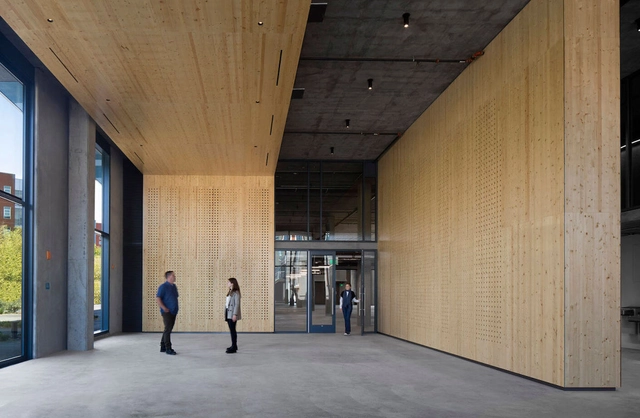
Mass timber is emerging all across North America. Beyond the benefits of natural materials and visible structures, the capabilities of industrialized offsite construction are beginning to change the model of delivery for an increasing range of buildings. When a California owner-developer proposed the first mass timber building in the state, they chose the experience, scope, and qualifications carefully, and the entire mass timber package was delivered on a train from Quebec, Canada.
California joined international code trends acknowledging the performance and safety of mass timber construction types in September of 2022. Mass timber may seem new, but it is a modern relative of historic mill and church buildings known to architects as Type IV Heavy Timber. This code category was created to recognize the building type’s resistance to fire and its ability to be adapted to new uses. The new Type IV code types (A, B & C) allow for purpose-built mass timber systems at three different scales, topping out at 18 stories.

Mass timber columns, beams, and floor slabs are manufactured offsite and used most commonly for the load-bearing core elements of the building. The CLT panels (Cross-Laminated Timber) get a lot of attention but they are one part of a system in which post and beam elements can be made of glue-laminated timber or hybrid systems created with steel and concrete. Unlike commodity lumber, the elements are created exactly for the project in a kit of parts. This introduces a new dynamic that is often less visible in the media attention on cranes rapidly erecting mass timber structures, or new factories coming online.
“Logistics is like a quiet art form; people never think of it until the supply chain is stretched or strained,” says Eli Gould, Quebec Wood Export Bureau’s USA representative. “What I love about all the California examples is that it took some of the best logistical minds in the business and a fair amount of practice before we saw their success publicly.”
The tragic wildfires in northern California had already introduced a demand for rapid rebuilds, with more fire-resistant construction. The first Quebec prefab systems to reach the west were less publicized than mass timber, as high-end residential clients looked to the most experienced and custom offsite partners to rebuild towns like Malibu in 2019.
Although the scales may be different, students of logistics will see patterns in the practices of prefabrication experts from vertical companies who take responsibility for distant job sites. These companies refined strategies using marshalling yards for effective crane access in tight job sites, and sometimes even use the back-haul from their deliveries creatively as the pandemic brought shortages of various products nationwide.

The public proof is the 1 De Haro project in San Francisco, which was delivered by train from northern Quebec, and accompanied by the full-scope project managers and onsite installation services of Nordic Structures. Lee Ishida, from developer SKS, had this to say: “We had a positive and successful experience working with Nordic Structures. Our shared values of sustainability, collaboration, and pioneering spirit resulted in San Francisco’s first cross-laminated timber building in the Bay Area at 1 De Haro. We continue to collaborate with Nordic, have expanded our Canadian industry network, and look forward to the future of mass timber in the Bay Area.”
With a non-profit matchmaking service tailored to various scales of US projects and offsite producers, the Quebec Wood Export Bureau (QWEB) can help find the right company and know-how for upcoming next projects. Click here to contact QWEB’s Wood Construction Group.



